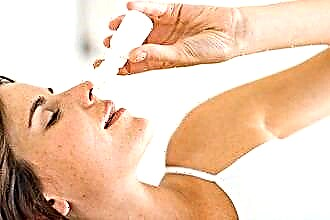Sinusitis is one of the varieties of sinusitis, in which the mucous membrane of the maxillary airways becomes inflamed. This disease is characterized by wide symptoms, which covers not only the affected paranasal cavities, but also adjacent organs (eyes, ears, teeth), and also leads to intoxication of the whole organism. Maxillary sinusitis can manifest itself both in an acute form and in a sluggish one, which leads to regular exacerbations and significantly worsens a person's quality of life. Next, consider how to cure chronic sinusitis forever at home.
Features of chronic sinusitis
 Sluggish sinusitis is most often the result of an acute form of the disease, which was transferred without treatment, or therapy was inadequate.
Sluggish sinusitis is most often the result of an acute form of the disease, which was transferred without treatment, or therapy was inadequate.
Often, patients stop taking medications ahead of schedule at the first signs of improvement, which leads to chronicity of the disease and the development of resistance of pathogenic bacteria to certain types of antibiotics.
Other common causes of acute to chronic sinusitis include:
- The presence of persistent infections in the nasopharynx (prolonged tonsillitis and rhinitis).
- Curvature of the nasal septum, the presence of thorns on it, atrophy and proliferation of tissues in the nasal cavity.
- Violation of the outflow of secretion and the natural passage of the air flow caused by the growth of polyps, cystic and pseudocystic formations.
- Dental infections and failed dental surgeries.
- Exposure to allergens.
- Weakened local or general immunity.
- Bad habits (smoking, drinking alcohol).
- Unfavorable living and working conditions (polluted air, work with toxic substances, hypothermia).
Sluggish sinusitis develops slowly and latently. This makes it difficult to make an accurate diagnosis without a special examination. The most unpleasant feature of this form of the disease is that after a period of remission, sometimes quite long, an exacerbation necessarily occurs, which brings a lot of unpleasant sensations to the patient.
Among the symptoms of sluggish sinusitis, the following are most characteristic:
- Nasal congestion, periodically when the head is tilted, a discharge begins that does not lend itself to therapy according to the standard scheme. On visual examination, the attending physician discovers a persistent streak of pus that flows out from under the middle nasal concha.
 Headache that is especially intense when lying down. As a rule, the pain syndrome is concentrated near the eye sockets or behind them, it can be mild, from time to time intensifying and radiating to the teeth and nose.
Headache that is especially intense when lying down. As a rule, the pain syndrome is concentrated near the eye sockets or behind them, it can be mild, from time to time intensifying and radiating to the teeth and nose.- Sensation of a foreign body in the throat. This is because infected mucus from the adnexal chamber runs down the walls of the throat, irritating them.
- Pressing sensations in the cheeks, where the maxillary sinuses are located. The face becomes heavy, the sensations intensify when bending over.
- Morning conjunctivitis and swelling of the eyelids due to the passage of infection into the eye sockets.
- Involuntary lacrimation, which occurs without the presence of an irritant, is a consequence of the penetration of pathogens into the lacrimal sac.
- A feeling of stuffiness in the ears.
- Violation of the function of smell.
Traditionally, chronic sinusitis is treated with antibiotics for a long period of time, mucolytics, decongestants, anti-allergic and anti-inflammatory drugs, steroid hormones, immunomodulators. Often it is necessary to resort to surgical intervention to drain purulent exudate (puncture) or eliminate defects in the nasal septum.
The principles of treating the disease at home
When choosing how to treat the latent form of sinusitis, many patients take into account that pharmaceuticals will need to be taken for a long time, and this can threaten with side effects that affect other organs. Therefore, the therapy of sinusitis at home is very popular, when it is possible to use both pharmacy medicines and folk recipes. To achieve the best result, all procedures should be discussed with the attending otolaryngologist, who can provide professional advice and warn against rash decisions.
Basic principles of home treatment:
- You should be patient, since you will have to carry out procedures and take medications for several months with short interruptions. Chronic sinusitis at home cannot be quickly cured.
 Follow the doctor's orders, do not experiment with your own health.
Follow the doctor's orders, do not experiment with your own health.- Applying folk recipes, one should pay special attention to the possible presence of an individual intolerance to certain biologically active components in the patient, as well as allergies.
- Treatment with phytopreparations should be started with small doses, increasing them to standard indicators only after confirmation of a positive reaction of the body.
- In the absence of the desired effect or deterioration of the condition, immediately stop treatment and consult a doctor.
Home treatment should be comprehensive. It is aimed, first of all, at suppressing the pathogen, relieving the inflammatory process, normalizing the outflow of secretions, eliminating tissue edema and regenerating the epithelial layer of the mucous membrane.
Treatment with folk methods
In folk recipes for the treatment of sinusitis, juices, tinctures and decoctions of plants, bee products, oils, alcohol, milk are used.
Timely evacuation of sputum is the basis for the normalization of the entire respiratory system. The best way to drain mucus is by flushing the nasal passages and accessory pockets. Before the procedure, it is necessary to clean the nasal passages, if necessary, 10 minutes before starting to use a vasoconstrictor. Effective mixtures for rinsing the nose:
- Dilute the beetroot juice with water, add half a teaspoon of sea salt and stir thoroughly. Carry out rinsing according to the classical procedure, without producing significant pressure.
- Mix dry sage and chamomile herb in equal proportions, brew in a water bath for 30 minutes, then strain and cool. Add a spoonful of honey before rinsing.
- Green tea, St. John's wort, black currant leaves or a series of boiling water are poured and infused for 20 minutes.
- A solution of sea salt (0.5 teaspoon per glass of water) can be applied alone or used in combination with other ingredients.
 You can use ready-made solutions based on sea water and sea salt, which are sold in pharmacies.
You can use ready-made solutions based on sea water and sea salt, which are sold in pharmacies.
The most common of these are Dolphin and Aqua Maris.
In addition to the drug itself, the package also includes convenient devices for the procedure.
Warming up with sinusitis is done only with dry heat. To do this, you can use:
- hard boiled egg
- boiled potatoes,
- a cotton bag filled with salt, cereal or sand,
- a blue lamp (Minin's reflector) for 15-30 minutes 2-3 times a day.
It is necessary to pay attention to the fact that during the period of exacerbation of the disease, any manipulations aimed at warming up the sinuses should not be carried out, as this can dramatically worsen the patient's condition.
Another method available to everyone at home is a variety of compresses.There are a great many of them, so we will focus only on those about which there are many positive reviews on the Internet:
- Finely grated propolis and thick natural bee honey are mixed until a homogeneous mass is formed. Then a cake is formed from it and applied to the affected cavity at night, securing it with a medical plaster.
- Several bay leaves are poured over with water and simmered. The tissue moistened with the broth is applied to the maxillary sinuses and covered with a towel, held until the tissue cools. The procedure is repeated several times in a row. This recipe is especially good for treating recurrent chronic sinusitis.
- A piece of gauze is moistened in freshly squeezed black radish juice, then it is additionally impregnated with heated vegetable oil and placed on the sore sinus. A bag of heated salt is placed on top. Enough two repetitions a day for 1 hour for an adult and half an hour for a child.
- Dilute the clay with hot water to a dough consistency. Put gauze soaked in vegetable oil on the cheeks in the projection of the accessory pocket. Put warm clay cakes on it and keep for about an hour.
- Mix egg white, aloe juice and honey (1 teaspoon each) and onion juice (0.5 teaspoon) and make compresses from the heated mixture.

A good result is the use of homemade nose drops. They are more often used in the initial stages of the disease, but some help with a sluggish form.
- Mix the juice from potatoes, blue onion and melted honey in a 1: 1 ratio until smooth. Instill in case of nasal congestion several times a day. The resulting product can be stored in the refrigerator for up to a week.
- For 4 parts of water, add 1 part of glycerin and 20 g of mummy (10 tablets of 0.2 g). Stir until all components are completely dissolved, drip 3 times a day. Treatment is carried out according to the following scheme: drip the nose for 3 weeks, after which a week break and again the use of glycerin solution.
- From the cyclamen root grated on a fine grater, juice is squeezed out through a cloth or gauze, which is diluted with water and infused in the refrigerator. 2 drops of the tincture should be injected into each nostril, and then take a horizontal position for 10-15 minutes. The effectiveness of therapy will increase if you drink a glass of honey broth after the procedure. The cyclamen root can be purchased at the pharmacy or in the market, and can also be cut from a flower that is sold in a pot. When working with cyclamen, you need to be careful, because its juice in a concentrated form is poisonous and dangerous to human health.
- Combine 35 grams of alcoholic calendula tincture with 250 milliliters of saline solution (1 teaspoon of salt). The resulting liquid, 10 ml, is injected into the nasal passages with a syringe twice a day. This procedure is recommended to be combined with a solution from the juice of the scrub bulbs (1: 1 with water, drip three times a day).
Drug therapy
 Alternative methods in the treatment of chronic sinusitis are good as an adjuvant, but traditional medications cannot be dispensed with. In particular, antibiotic therapy is a prerequisite for suppressing the activity of pathogens in the accessory pockets of the nose. A distinctive feature of sluggish sinusitis is that it must be treated not only during an exacerbation, but also during remission. The difference lies only in the drugs and procedures prescribed and the regimen for their use.
Alternative methods in the treatment of chronic sinusitis are good as an adjuvant, but traditional medications cannot be dispensed with. In particular, antibiotic therapy is a prerequisite for suppressing the activity of pathogens in the accessory pockets of the nose. A distinctive feature of sluggish sinusitis is that it must be treated not only during an exacerbation, but also during remission. The difference lies only in the drugs and procedures prescribed and the regimen for their use.
- Antibiotics During the period of exacerbation, penicillin drugs in tablets (Ampicillin, Penicillin), as well as powder cephalosporins in the form of injections and solutions for washing the sinuses (Cefazolin, Ceftriaxone) are most often used. During remission, macrolide antibiotics are often prescribed in small doses, which are taken for a long time (Macropen, Azithromycin). It is unacceptable to self-medicate with antibiotic therapy. Only a doctor can prescribe drugs of this kind after determining the pathogenic bacteria that are the causative agents of the disease.
- Mucolytics (Ambrobene, ACC, Mukodin, Sinupret), herbal expectorants (alteika, licorice root) are prescribed to liquefy the mucous contents of the air chambers and facilitate the removal of exudate. At normal temperatures, during the period of illness retreat, you can go to the bathhouse or soak your feet in hot water. If the patient feels this deterioration of the condition, the procedure should be interrupted immediately.
- Removal of puffiness from the tissues of the nasal cavity and anastomosis. For this, vasoconstrictor sprays and drops (Nazivin, Rinazolin, Galazolin) are used, as well as local herbal preparations that help reduce inflammation and regeneration of the mucous membrane (Ingalipt, Kameton, Bioparox, Pinosol, Polydexa).
- Rinsing and irrigation of the nasal passages with Furacilin, Chlorophyllipt, Rotokan, Decametoxin. This manipulation is sufficient to carry out 4 times a day, 10 minutes after using the vasoconstrictor.
Preventive actions
 In order to reduce the number of exacerbations or avoid them altogether, one should not forget about regular prevention of the disease. There are a number of generally accepted proven methods that will strengthen the body and put a barrier in the path of pathogens that cause maxillary sinusitis:
In order to reduce the number of exacerbations or avoid them altogether, one should not forget about regular prevention of the disease. There are a number of generally accepted proven methods that will strengthen the body and put a barrier in the path of pathogens that cause maxillary sinusitis:
- Dress for the season, avoid hypothermia, avoid drafts.
- An active lifestyle (walks in the fresh air, sports and physical education).
- Timely treatment of respiratory and dental diseases, the body should not have sources of infection that can provoke an exacerbation of chronic sinusitis.
- Promote the normal functioning of the epithelial layer of the mucous membrane, prevent it from drying out. To do this, you can purchase a household air humidifier, as well as regularly irrigate the nasal cavity with salted water and take a shower more often in summer.
- Avoid allergens, especially during seasonal flowering.
- Do not swim in chlorinated pools or polluted water.
- Take vitamin and mineral complexes to strengthen general immunity.
- Quit smoking and try to avoid places where tobacco smoke and other active substances in the air are present.

 Headache that is especially intense when lying down. As a rule, the pain syndrome is concentrated near the eye sockets or behind them, it can be mild, from time to time intensifying and radiating to the teeth and nose.
Headache that is especially intense when lying down. As a rule, the pain syndrome is concentrated near the eye sockets or behind them, it can be mild, from time to time intensifying and radiating to the teeth and nose. Follow the doctor's orders, do not experiment with your own health.
Follow the doctor's orders, do not experiment with your own health.

